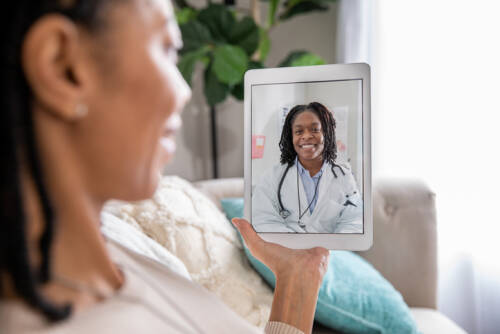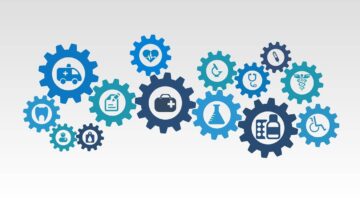Bringing care to people where they are improves community health outcomes — we must operate with more urgency to shore up care resources in rural areas.

Roughly 20 percent of the U.S. population resides in rural areas, and over 10 percent of the population lives in poverty. These individuals tend to feel the weight of provider shortages and high costs, which can result in increased prevalence of chronic conditions and other challenges more intensely than the rest of the population, not to mention the additional barriers that limit their access. In turn, rural populations fall behind on care. It’s time to rethink how, where, and when care is delivered in rural areas. By using digital and virtual solutions to address member needs in their homes and communities, long-term health outcomes can be improved, and health disparities can be addressed.
Device-enabled virtual care leveraging remote monitoring tools broadens access to care by meeting members where they are and extending the reach of care team resources. In many cases, individuals don’t even have to leave their house to capture and share vital health information with a trusted care team that can prompt earlier intervention and timely care. This model breaks down roadblocks and opens the door for a new era of improved health outcomes for the most vulnerable.
Addressing rural barriers to care

Provider shortages are hitting rural communities hard. Only about nine percent of physicians practice in rural areas in the U.S., contributing to lengthy wait times for appointments and patients having to travel long distances to see a doctor. Routine care is further delayed or forgone among patients who lack reliable transportation or the time and means to disrupt their day-to-day lives.
One in four rural Americans is enrolled in Medicaid, and considering the high prevalence of chronic conditions among Medicaid members, it’s no surprise that health disparities disproportionately impact the rural population. According to the CDC, patients in rural communities are more likely to die from conditions such as heart disease, stroke, and chronic lower respiratory disease. Faced with fewer care options, patients can’t regularly see a provider to help manage their conditions, driving less-than-ideal outcomes.
Device-enabled virtual care empowers patients regardless of where they live. These services support member engagement and care management operations that enable seniors, people living with chronic conditions, and people living with disabilities to maintain their independence and avoid long‐term care facilities, prevent avoidable emergency room use, hospitalization, and hospital readmission.
Although not a solution for all people in rural communities, it addresses a key barrier for many. Location no longer prevents patients from receiving timely care or activating and managing a care plan to reduce risks. From personal emergency response systems as an always-on engagement channel to vitals monitoring devices paired with clinical and non-clinical care resources to support patients based on need, virtual care enabled through remote monitoring devices can help prevent complications, minimize costly care, and increase care engagement.

In addition to monitoring devices patients can use in their homes, community health stations are a valuable, cost-effective resource that helps more patients receive care. In many rural areas, patients experience internet connectivity issues that hinder access to services like telehealth. Community health stations help patients overcome connectivity barriers and monitor their risks for conditions such as high blood pressure, obesity, type 2 diabetes, and stroke. Integrating health stations into convenient spaces within the community, such as places of worship and senior centers, enables more patients to measure key health indicators, identify potential warning signs, and connect directly to care, turning insights into care when it matters most and spurring early action.
The result? Patients and care teams have access to real-time health data, with abnormal vitals readings and alerts flagged to patients and care teams before an emergent episode. Care teams can develop more personalized care plans, leverage non-emergent interactions to support education and gap closure, and ultimately, drive better outcomes. And patients become more active in their care, too. Rather than waiting to seek care when it becomes dire, patients have a direct line to the right level of support whenever they need it.
Delivering measurable outcomes
Monitoring solutions drive tangible results in rural communities. The Michigan Center for Rural Health (MCRH) is one example. In 2022, MCRH launched an 18-month pilot program that improved patient outcomes and reduced clinician burden. The number of patients with controlled blood pressure readings doubled, those with previously uncontrolled hypertension achieved readings in the normal range, and many improved their blood glucose levels and weight.
A 2024 study assessed rural New York patients prone to heart failure exacerbation and the impact of monitoring solutions on preventing re-exacerbations. And the results were significant. The number of emergency room visits and hospitalizations for heart failure fell by over 90% and 80%, respectively, and other cardiovascular hospitalizations were cut in half. Office visits also declined by 15% after initiation of the monitoring solution, and unscheduled or urgent office visits fell by nearly 75%.
A study evaluating the effect of telemedicine and monitoring solutions on rural Americans’ health found substantial improvements in patient outcomes. Patients experienced a decrease in disease-specific markers, a reduction in symptom severity, and a general improvement in health status. Additionally, patient satisfaction improved, and direct healthcare costs were significantly reduced.
These examples highlight the importance of monitoring solutions for rural and isolated individuals, especially for patients who are homebound and lack strong social support. The results exemplify the value that monitoring can bring to rural healthcare and the significant potential these services hold to improve outcomes and care for rural patients.
The industry must operate with more urgency to shore up care resources in rural areas. The tools exist. The results are proven. Now we must act. Device-enabled virtual care management broadens access to care while promoting independence, supporting dignity, and helping patients stay healthier at home and in their communities.
SHARE
RESOURCES